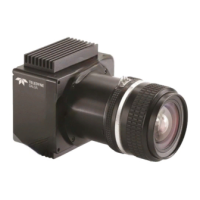37 Piranha 2 User’s Manual
03-032-00493-14 Teledyne DALSA
To perform dark calibration:
1. Stop all light from entering the camera. (Tip: cover lens with a lens cap.)
2. Verify that output signal level is within range by issuing the command gl or
gla (a valid range is 1-127). If the signal level is too low, adjust the analog offset
(sao). If the signal level is too high, ensure that no light is entering the camera,
reduce the analog offset or reduce the gain level (sg).
3. Issue the command ccf. The camera will respond with OK> if no error occurs. Dark
calibration automatically calibrates FPN coefficients and digital offset.
To perform a dark calibration with an analog offset value:
Use the ccf [i] command, where i is the analog offset DN. When the optional
parameter is provided, this command sets the analog offset first to i before calculating
the FPN coefficients range from 1 to 100DN for 8-bit data mode, and 4 to 400DN for
10-bit data mode for the specified region of interest. If value is left blank, current offset
values are used.
4. After the calibration is complete, you can save these settings, and the PRNU
coefficients, to non-volatile memory so they will be remembered after power-down.
To do so, issue the command wpc.
White Light Calibration
White light calibration is more complex than dark calibration because the camera
attempts to create a flat white image. This calibration corrects PRNU effects as well as
non-uniform lighting and lens vignetting affects.
White light calibration requires a clean, white reference. The quality of this reference is
important for proper calibration. White paper is often not sufficient because the grain in
the white paper will distort the correction. White plastic or white ceramic will lead to
better balancing.
There are several restrictions that must be met in order for the calibration to succeed:
1. The camera is sufficiently sensitive to detect 60 Hz ambient light flicker which may
affect camera performance and calibration results.
2. The light level must be set so that all pixels are between 64DN and 254DN, otherwise
a warning will be sent stating that the camera could not calibrate all pixels to the same
level. Use the gl command to determine input level. If the signal level is too low or
too high, adjust analog gain using the command sg.
These restrictions are all tested within the calibration algorithm and the camera will
report an informal message code if any of these conditions could not be met.
Note: If your
illumination or white
reference does not
extend the full field of
view of the camera,
calibration will not be
successful. The camera
will send a warning.
All manuals and user guides at all-guides.com

